| Dodging Strategy |
| By: Don Zimmerman and Peter England
Originally Published in: Men's Lacrosse Provided by: Human Kinetics When dodging, you also have to decide whether you need to set up your defender or your defender has set himself up; then you want to get the defender to react in the opposite direction of where you want to go. Remember, offense is a game of opposites. Either way, you're looking for the defender to over commit and make a mistake in some manner. Then you are going to take advantage of it by going the opposite way. In some dodges, the defender is setting up the dodge for you. The defender is attacking you, and in doing so, he creates the opportunity for you to dodge. If the defender makes a mistake, you should take advantage of that mistake and dodge around the over committing defender. For example, if your defender is running at you out of control, then the defender has set himself up, and you can react to his overcommitment (reactive). In other cases, you will be setting up the dodge yourself. If your defender is playing solid, squared-up defense and is holding his ground, you will need to attack him and initiate the dodge. When your defender is under control and is not making a mistake, you have to set him up and cause him to make a mistake (proactive). Again, a north-south dodge is based on the principle that the shortest distance between two points is a straight line. The two points would be the dodger and the center of the goal. The play would be analogous to a football tailback running directly through the offensive line instead of running outside the tackles and avoiding the defense with speed or deception. If you use a north-south dodge, you run and sprint at your defender, and you use a first-move fake and burst. Your defender will open up his hips and take a deep drop step because he wants to adjust his body position and get to a better down field angle (see figure 4.5a). The defender wants to run hip to hip with you, the attacker, so you should watch the defender's hips. Once your defender opens up his hips and drop-steps, you should attack the defender's near hip, which is the hip closest to you after he drop-steps (see figure 4.5b). You should use a sudden change of speed or change of direction, get an overreaction from the defender, cut back against the near hip, and then go hard to the goal. If you beat your defender early with a good first move and separate from your defender, you can then go toward the goal uncontested. You won't have to worry about the defender checking you, and you will become more dangerous because you can extend your arms and free up your hands to pass, feed, or shoot. You want to beat your defender cleanly so you can focus on the next defender. If you don't put a good first move on your defender, you will have to deal with him the entire time you're pressing to the goal. You will have to protect your stick more, and you won't be able to get your arms and hands free to release the ball.
If you are being approached by an opponent, you should shift your body position from a squared-up position to a sideways position similar to martial arts maneuvers. Martial arts teaches you that if you are being approached by a potential enemy, you should turn your body to a sideways position because you will have less of your body exposed to the aggressor. Remember, everything (torso, hips, shoulders, hands, and stick) is one piece and should work together. Various types of north-south dodges can be used, including bull, face, roll, and split dodges. Some north-south dodges will require you to change your hand positions on the stick, while others will not. For some north-south dodges, you will use your legs to cross over the imaginary straight line to the goal. Irrespective of the specific technique used, all north-south dodges are direct, aggressive moves against the opponent, and each dodge involves either a proactive or reactive approach. BULL DODGE A bull dodge, as shown in figure 4.7, FACE DODGE For a face dodge, as shown in figure 4.8, you cross over the straight line, and you don't change hands on your stick. You want to move your defender off the line. As you approach you defender, you should be in a loaded position with you body weight back and your stick back in a triple-threat position. When you execute a face dodge, you step over the line, but you don't want to stray too far from the line. In a reactive situation, your defender is running at you out of control, so you should react to his overcommitment and face dodge him. If your defender approaches you with his stick high in the air to block a pass, he may have lost his low center of gravity, which makes him easier to dodge. In a proactive situation, the successful face dodge is a two-step move: You fake a pass and then execute the face dodge. Your defender is low and in an athletic position. You set up the defender by running up to him, turning your body and stick to the side, and pretending to throw to a teammate. Part of the deception is that your defender sees you pick up the tempo of your cradle (to a control cradle tempo) as if you're going to throw to somebody. You don't want to overdo the fake. If you're in a throwing position, your defender will tend to stand up out of his athletic position and raise his stick to knock down the pass. This makes him more vulnerable to a face dodge. ROLL DODGE For a roll dodge, as shown in figure 4.9, you cross over the straight line, similar to the face dodge, and you don't change hands on your stick. You want to move your defender off the line. As you approach the defender, you should be in a loaded position with your body weight back and with your stick back in the triple-threat position. You step over the line and get the defender to commit to one side; then you come back with a roll dodge. For a right-handed player, you turn your upper body before planting your left pivot foot. You plant your left foot and continue to roll your upper body Stick and stick. You swing your right foot and plant your left foot back on the line. You don't want to overstep. Everything is one continuous movement as your body and stick roll back In a reactive situation, your defender is running at you out of control with his stick down low. In this case, you would roll dodge the defender because it protects your stick better than a face dodge. In a proactive situation, you can use a combination dodge: bull dodge into a roll dodge. You use a bull dodge to set up the roll dodge. More important, a roll dodge is a counter move. A roll dodge is not a move that you would go to initially. It's almost as if you're forced to roll. For example, if you're an attackman, you may prefer to dodge around the goal and shoot the ball, but if the defender gets way upfield on you, you can counter with an inside roll. The main advantage of a roll dodge is maximum stick protection. The disadvantage is that you take your eyes off the field and thus lose sight of both the offense and the defense. You lose sight of all the other players on the field, and this inhibits your ability to read and react. Many defenders are taught to slide when the ball carrier turns his back to them. SPLIT DODGE For a split dodge, as shown in figure 4.10, you cross over the straight line, and you change hands on the stick (this is the only dodge that requires you to change hands). A split dodge is a combination of a face dodge and a bull dodge. A split dodge is like a face dodge, but you switch hands on the stick. A split dodge is like a bull dodge, but you are switching hands and crossing over the straight line. When using the split dodge, one successful strategy is "setting up your strength." You put the stick in your weaker hand, make a first move, and then perform the split, pulling the stick to your stronger hand for a pass, feed, or shot. |



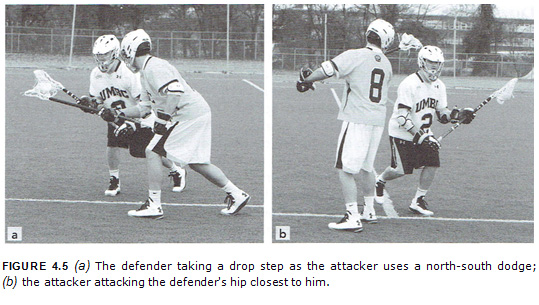
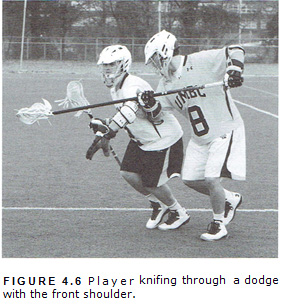 Everything is balanced and works in unison. If you rotate your trunk and turn your hips and shoulders, then your hands and stick go back naturally so that the stick is protected and your body and stick are in the loaded position. Your core muscles are torqued back for power, your body weight is on your back foot, and your stick is back so you are ready to release the ball. Your objective is to knife through the dodge by leading with your front shoulder (see figure 4.6).
Everything is balanced and works in unison. If you rotate your trunk and turn your hips and shoulders, then your hands and stick go back naturally so that the stick is protected and your body and stick are in the loaded position. Your core muscles are torqued back for power, your body weight is on your back foot, and your stick is back so you are ready to release the ball. Your objective is to knife through the dodge by leading with your front shoulder (see figure 4.6).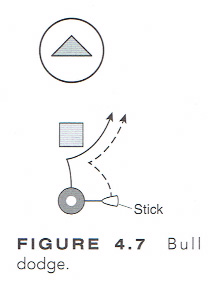 is the only dodge that doesn't involve crossing over the imaginary straight line to the goal. When executed in a proactive manner, the bull dodge is the simplest of dodges. It's a simple "one move and go." You just want to sprint by the defender or use your physical strength and power to out muscle the defender. You execute a dip-and-go move. To do this, you fake a face dodge (dip) and then perform a bull dodge. You should watch your defender's hips and get the defender off the line by using a fake face dodge. You lower your shoulder, and your stick automatically starts to come across the front of your body. you plant your off-stick foot, shift your body and stick as one unit back to the line, and go. Dip-and-go is similar to the game of "tag" where you fake one way and go another. When using a reactive approach, as your defender approaches you, you will wait until the last moment, give him a fake face dodge one way, and go hard the other way.
is the only dodge that doesn't involve crossing over the imaginary straight line to the goal. When executed in a proactive manner, the bull dodge is the simplest of dodges. It's a simple "one move and go." You just want to sprint by the defender or use your physical strength and power to out muscle the defender. You execute a dip-and-go move. To do this, you fake a face dodge (dip) and then perform a bull dodge. You should watch your defender's hips and get the defender off the line by using a fake face dodge. You lower your shoulder, and your stick automatically starts to come across the front of your body. you plant your off-stick foot, shift your body and stick as one unit back to the line, and go. Dip-and-go is similar to the game of "tag" where you fake one way and go another. When using a reactive approach, as your defender approaches you, you will wait until the last moment, give him a fake face dodge one way, and go hard the other way.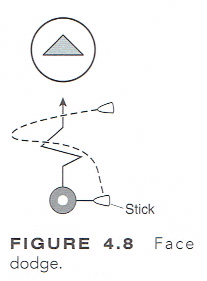 Everything is one piece: Stick and body act as one unit. You turn your trunk, and this shifts your stick Stick from shoulder to shoulder. Your trunk moves, but your arms and stick stay relatively still. Your shoulder comes across the front of your body, and the stick stays in the same relative position. You should keep your stick in the same hand and return your stick to its original loaded position. If you change hands, your stick will be checkable from behind. If you make a big, sweeping stick motion during your face dodge, you will have to come all the way back to the loaded position.
Everything is one piece: Stick and body act as one unit. You turn your trunk, and this shifts your stick Stick from shoulder to shoulder. Your trunk moves, but your arms and stick stay relatively still. Your shoulder comes across the front of your body, and the stick stays in the same relative position. You should keep your stick in the same hand and return your stick to its original loaded position. If you change hands, your stick will be checkable from behind. If you make a big, sweeping stick motion during your face dodge, you will have to come all the way back to the loaded position.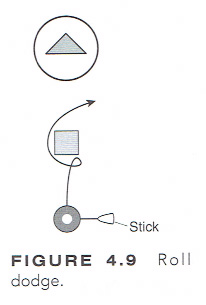 together. You use your body to protect the stick. You should keep your stick in the same hand. If you switch hands, you will have a tendency to hang the stick, which makes it more checkable. You should keep your stick perpendicular to the ground and keep it tight to your body to protect the stick. If your stick goes parallel to the ground, then it's more checkable. As you come out of the roll dodge, you want to get your stick upfield and chase your stick with your body (i.e., lead with your stick). By getting your stick upfield, you avoid hanging or dragging your stick, and you move your stick as far away from your defender as possible (separating your stick from the defender). Once you achieve stick and body separation, you adjust your body to the ball, which happens to be in your stick. When you completely roll back out of a roll dodge, you want to return to a position with your opposite shoulder forward (not square toward your target) and return to a loaded position.
together. You use your body to protect the stick. You should keep your stick in the same hand. If you switch hands, you will have a tendency to hang the stick, which makes it more checkable. You should keep your stick perpendicular to the ground and keep it tight to your body to protect the stick. If your stick goes parallel to the ground, then it's more checkable. As you come out of the roll dodge, you want to get your stick upfield and chase your stick with your body (i.e., lead with your stick). By getting your stick upfield, you avoid hanging or dragging your stick, and you move your stick as far away from your defender as possible (separating your stick from the defender). Once you achieve stick and body separation, you adjust your body to the ball, which happens to be in your stick. When you completely roll back out of a roll dodge, you want to return to a position with your opposite shoulder forward (not square toward your target) and return to a loaded position.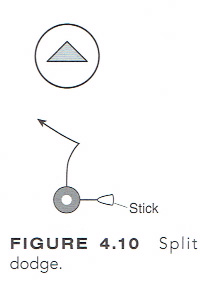 You want to move your defender off the line. As you approach the defender, you should be in both a loaded position and a triple-threat position. You plant your foot and shift your body weight and stick to the other side of your body. Your plant foot is the same as your stick hand. When you switch hands, your feet shouldn't cross over. To switch hands on the stick, you should use a two-step move. First, you slide your bottom hand up the shaft to just below the top hand and then move the stick in front of you with the pocket facing toward you. Second, you release the top hand, move it to the butt end position on the stick, and move the stick to the other side of your body. The stick head should go from "box to box" when you switch hands. You go hard after switching hands and move your stick upfield, adjusting your body to the ball (which is in your stick) and back to the triple-threat position.
You want to move your defender off the line. As you approach the defender, you should be in both a loaded position and a triple-threat position. You plant your foot and shift your body weight and stick to the other side of your body. Your plant foot is the same as your stick hand. When you switch hands, your feet shouldn't cross over. To switch hands on the stick, you should use a two-step move. First, you slide your bottom hand up the shaft to just below the top hand and then move the stick in front of you with the pocket facing toward you. Second, you release the top hand, move it to the butt end position on the stick, and move the stick to the other side of your body. The stick head should go from "box to box" when you switch hands. You go hard after switching hands and move your stick upfield, adjusting your body to the ball (which is in your stick) and back to the triple-threat position.


